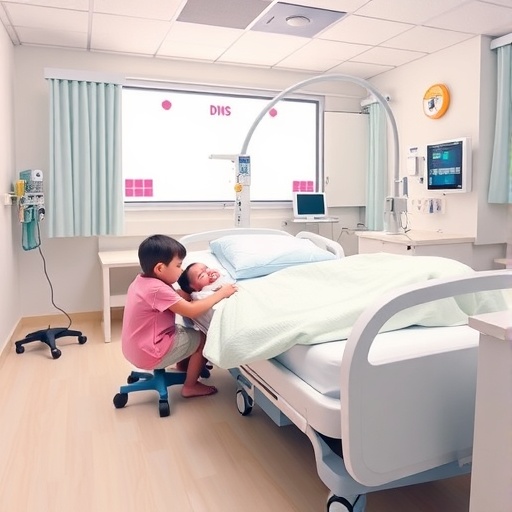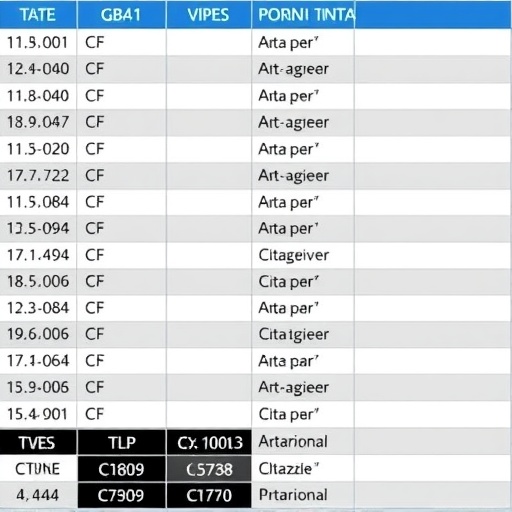In a groundbreaking study poised to reshape neonatal care, researchers have unveiled compelling evidence that the architectural design of Neonatal Intensive Care Units (NICUs) significantly influences the neurodevelopmental outcomes of the most vulnerable newborns—those born before 29 weeks of gestation. This investigation delves into the comparative efficacy of single-family room (SFR) NICUs versus traditional open-bay configurations, shining a light on how the environments where preterm infants spend their earliest days can have lasting impacts on their developmental trajectories.
The study addresses a critical question in neonatology: how does the physical environment in which extremely preterm infants receive care affect their brain development and subsequent neurocognitive outcomes? Historically, open-bay NICUs, where multiple infants share a single, often noisy and brightly lit room, have been standard due to their efficiency in patient monitoring and staff workflow. However, evolving theories about sensory stimulation, stress reduction, and family involvement have led to the adoption of single-family room NICUs, designed to provide privacy, quieter settings, and enhanced parental engagement.
To explore these hypotheses, the research team conducted a retrospective observational study encompassing a cohort of neonates born before 29 weeks’ gestation—a group known for high vulnerability due to underdeveloped organ systems and increased risks for neurodevelopmental impairments. The infants were cared for in NICUs employing either the single-family room or open-bay architectural designs. Crucially, neurodevelopmental outcomes were assessed at corrected ages of 18 to 30 months, enabling an evaluation of the early impact on cognitive, motor, and sensory development.
The methodology employed rigorous neurodevelopmental assessment tools validated in preterm populations, accounting for various confounding factors including severity of illness, socioeconomic status, and perinatal complications. This approach allowed for a nuanced understanding of how environmental factors intrinsic to NICU design may contribute independently to the developmental trajectories of these infants. It also underscored the multifactorial nature of neonatal outcomes, where medical and environmental variables intertwine.
Findings revealed that infants cared for in single-family room NICUs demonstrated significantly improved neurodevelopmental outcomes compared to those housed in open-bay units. These improvements spanned cognitive function, fine and gross motor skills, as well as language acquisition. Importantly, the data suggested that the benefits were not merely due to enhanced medical interventions or staffing patterns but were associated with the inherent features of the SFR setting.
One proposed mechanism for this enhancement relates to the modulation of sensory inputs. Single-family rooms provide a controlled reduction in noise pollution and bright artificial lighting, factors known to contribute to stress and disorienting sensory overload in preterm infants. By attenuating these environmental stressors, the SFR design may contribute to a more stable and supportive milieu that fosters optimal brain maturation during a period of rapid growth and plasticity.
Moreover, the architectural configuration of SFR NICUs appears to facilitate greater parental involvement and bonding. The privacy and space afforded by individual rooms encourage skin-to-skin contact, extended visitation, and active participation in caregiving tasks. Parental presence has been extensively documented to support neurodevelopment by promoting emotional security and regulating infant stress responses. Hence, the SFR design may indirectly enhance neurological outcomes through the mechanism of enhanced family-centered care.
The implications of these findings are profound, suggesting that modifications to NICU design could serve as a non-invasive intervention capable of mitigating some neurodevelopmental risks associated with extreme prematurity. With neurodevelopmental impairments imposing significant burdens on individuals, families, and healthcare systems worldwide, this research proposes an innovative avenue for improving long-term outcomes by transforming the clinical environment itself.
However, the study also acknowledges limitations intrinsic to retrospective designs, including potential selection biases and variability in care practices across NICUs. The authors advocate for prospective, randomized trials to substantiate these results and refine recommendations for NICU architecture. Additionally, they highlight the need for cost-benefit analyses to balance the financial and logistical demands of transitioning to SFR models with the anticipated improvements in developmental outcomes.
This research emerges amid a growing body of literature emphasizing the environmental determinants of health in the neonatal period. It aligns with broader initiatives promoting trauma-informed and family-centered care frameworks in intensive care settings. The study further contributes to an evolving understanding that neonatal survival alone is insufficient; optimizing neurodevelopment and quality of life must be prioritized from the outset.
The comprehensive nature of the assessments, encompassing multiple domains of neurodevelopment, underscores the importance of holistic evaluation in premature infants. This approach mirrors contemporary views that successful neonatal care transcends survival metrics, integrating long-term functional and cognitive well-being as the ultimate objectives.
Furthermore, this work invites interdisciplinary collaboration among neonatologists, architects, developmental psychologists, and healthcare administrators to design NICUs that are scientifically informed and human-centered. By bridging clinical insights with architectural innovation, hospitals can become environments that nurture both the fragile physiology and emerging psyche of preterm infants.
In conclusion, the study by Ellebany et al. marks a pivotal advancement in neonatal medicine with its demonstration that NICU design is not a mere aesthetic or logistical choice but a critical determinant of neurodevelopmental health. As the global community seeks strategies to improve outcomes for preterm infants, the evidence advocating for single-family room NICUs provides a compelling argument for reimagining how neonatal intensive care is delivered worldwide.
The convergence of technology, environmental psychology, and neonatology embodied in this research offers a hopeful narrative for families navigating the difficult journey of prematurity. Through thoughtful design and evidence-based practice, the first environment a preterm infant inhabits after birth can become a catalyst for healthier development, better cognitive trajectories, and enriched life chances.
Future research directions will likely explore the neurobiological underpinnings of these environmental influences, employ neuroimaging modalities to visualize brain maturation differences linked to NICU design, and extend follow-up into later childhood to examine sustained cognitive and behavioral outcomes. This evolving arena underscores the critical intersection where medical care meets environmental design in shaping human development from its earliest moments.
Moreover, the findings resonate with a paradigm shift toward personalized neonatology, advocating that environments can be tailored not just by medical needs but by developmental neuroscience principles. As single-family rooms become more prevalent, understanding their optimal features and which patient populations derive maximal benefit will be paramount.
Overall, this study serves as a clarion call to clinicians, architects, and policymakers to prioritize the sensory and emotional landscape of NICUs, recognizing that these factors are inseparable from the biological care newborns receive. By embracing this holistic view, advances in neonatal survival rates can be matched by strides in neurodevelopmental outcomes, fulfilling a promise to improve not only lifespan but healthspan for our most fragile infants.
Subject of Research: Neurodevelopmental outcomes in preterm infants related to NICU architectural design.
Article Title: Association of NICU design on neurodevelopmental outcomes in preterm neonates born at less than 29 weeks’ gestation: a retrospective observational study.
Article References:
Ellebany, M., Raghuram, K., Kanburoglu, M.K. et al. Association of NICU design on neurodevelopmental outcomes in preterm neonates born at less than 29 weeks’ gestation: a retrospective observational study. J Perinatol (2025). https://doi.org/10.1038/s41372-025-02446-3
Image Credits: AI Generated
DOI: https://doi.org/10.1038/s41372-025-02446-3
Tags: environmental factors affecting brain developmentfamily involvement in neonatal careneonatal care architectural considerationsneurocognitive outcomes for preterm infantsNICU design impact on neurodevelopmentopen-bay NICU drawbackspreterm birth developmental riskspreterm infant care environmentsretrospective observational study on NICUssensory stimulation in NICUssingle-family room NICUs benefitsvulnerability of extremely preterm infants





